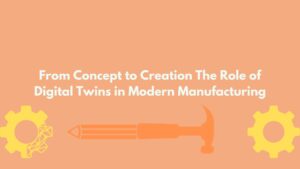Planning for the future in manufacturing is not just about staying afloat; it’s about steering towards innovation, efficiency, and sustainability. This blog delves into strategic approaches that manufacturers can adopt to navigate the complexities of the future.
1. Embrace Technological Advancements
a. Invest in Automation and Robotics
Automation and robotics are transforming manufacturing processes by enhancing precision, reducing human error, and boosting productivity. Investing in these technologies can streamline operations and enable manufacturers to meet the increasing demands for high-quality products.
b. Leverage the Internet of Things (IoT)
The IoT connects devices and systems, providing real-time data and insights. Implementing IoT solutions can optimize supply chains, improve equipment maintenance through predictive analytics, and enhance overall operational efficiency.
c. Explore Artificial Intelligence (AI) and Machine Learning (ML)
AI and ML can revolutionize manufacturing by predicting trends, optimizing processes, and enhancing decision-making. For instance, AI-powered quality control systems can detect defects early, reducing waste and improving product quality.
2. Focus on Sustainability
a. Implement Green Manufacturing Practices
Adopting sustainable practices not only helps the environment but also meets the growing consumer demand for eco-friendly products. This includes using renewable energy sources, reducing waste, and recycling materials.
b. Design for the Environment (DfE)
Designing products with their entire lifecycle in mind can minimize environmental impact. This involves choosing sustainable materials, designing for disassembly, and ensuring products are easily recyclable or biodegradable.
c. Compliance and Beyond
Staying ahead of environmental regulations and standards is crucial. Manufacturers should not only comply with current regulations but also anticipate future changes and proactively adapt their processes.
3. Foster a Skilled Workforce
a. Invest in Training and Development
The future of manufacturing relies on a workforce skilled in the latest technologies. Continuous training and development programs can equip employees with the necessary skills to operate advanced machinery and utilize new technologies effectively.
b. Cultivate a Culture of Innovation
Encouraging a culture that embraces change and innovation can lead to groundbreaking ideas and improvements. This involves creating an environment where employees feel valued and are motivated to contribute to the company’s growth.
c. Collaborate with Educational Institutions
Partnering with universities and technical schools can help bridge the skills gap. Internship programs, apprenticeships, and joint research initiatives can provide valuable hands-on experience and attract young talent to the industry.
4. Strengthen Supply Chain Resilience
a. Diversify Suppliers
Relying on a single supplier can be risky. Diversifying the supplier base can mitigate the impact of disruptions and ensure a steady flow of materials and components.
b. Implement Advanced Analytics
Using advanced analytics can provide insights into supply chain vulnerabilities and help in making informed decisions. Predictive analytics can forecast demand fluctuations and optimize inventory levels.
c. Foster Strong Relationships
Building strong relationships with suppliers and partners can lead to better collaboration and more reliable supply chains. Transparent communication and mutual trust are key components of these relationships.
5. Innovate in Product Development
a. Adopt Agile Methodologies
Agile methodologies can accelerate product development and bring innovative products to market faster. This involves iterative development, rapid prototyping, and continuous feedback loops.
b. Customer-Centric Approach
Understanding and anticipating customer needs can drive product innovation. Engaging with customers through surveys, feedback, and market research can provide valuable insights for developing products that meet their expectations.
c. Invest in R&D
A strong focus on research and development (R&D) can keep manufacturers at the forefront of technological advancements. Allocating resources to R&D can lead to the discovery of new materials, processes, and product designs.
6. Enhance Cybersecurity
a. Protect Digital Assets
As manufacturing becomes increasingly digital, protecting against cyber threats is paramount. Implementing robust cybersecurity measures can safeguard sensitive data, intellectual property, and operational systems.
b. Regular Security Audits
Conducting regular security audits can identify vulnerabilities and ensure that security protocols are up to date. This proactive approach can prevent potential breaches and minimize the risk of cyber-attacks.
c. Employee Training
Training employees on cybersecurity best practices is essential. Awareness programs can help employees recognize phishing attempts, avoid unsafe practices, and respond appropriately to potential threats.
Conclusion
Planning for the future in manufacturing involves a multifaceted approach that embraces technology, sustainability, workforce development, supply chain resilience, innovation, and cybersecurity. By adopting these strategies, manufacturers can not only navigate the challenges of today but also position themselves for long-term success and growth in an ever-evolving landscape. The future of manufacturing is bright for those who are prepared to adapt, innovate, and lead.









